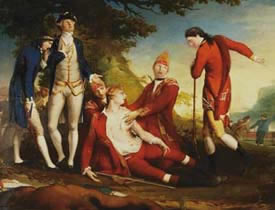| |
| | A NATIONAL TREASURE |
 |
| |
| | Death of General Wolfe, 1776 |
| | oil on canvas |
| | Signed lower right, James Barry Pinxt. |
| | Webster Canadiana Collection, W1987 |
| |
| |
| |
On 13 September 1759, French and British forces met in battle on the Plains of Abraham near
Québec City. It was a decisive episode in the Seven Years' War and changed the course of history
in North America. The two military leaders, French General Marquis de Montcalm (1712-1759) and
British General James Wolfe (1727-1759), both died from wounds suffered in the conflict. That
the British prevailed and power in North America subsequently shifted has echoed down through
history. |
| |
| |
Irish artist James Barry settled in London in 1771. He was already known there in artistic
circles through connections and a previous stay in the mid-1760s. Barry's return to London
happened to coincide with the exhibition at the Royal Academy of Benjamin West's landmark
Death of General Wolfe. Barry, who considered himself a rival to West in the field of history
painting, undoubtedly felt the enormous impact of West's success. He must have decided to mount
a challenge, in part redressing the acknowledged historical inaccuracy of the famous painting. |
| |
| |
Barry's Death of General Wolfe was exhibited at the Royal Academy exhibition in
1776. Appearing just five years apart, the West and Barry treatments were bound
to be compared. While straying from the known facts of Wolfe's death, West had
created a grand theatrical drama. In striving for greater accuracy, Barry
carefully studied reports of the event and developed a simpler composition,
which he claimed also possessed a more ennobling spirit. Despite its merits,
Barry's painting was not well received. It could not withstand comparison to
West's wildly popular and well established version. Disheartened by public
reaction, Barry never exhibited at the Royal Academy again and his painting sank
into obscurity. Since its rediscovery in 1901, however, it has come to be
recognized as an integral part of an important chapter in British art. |
| |
| |  |
|
| |
|